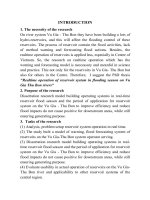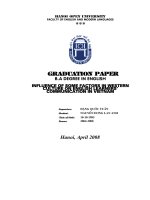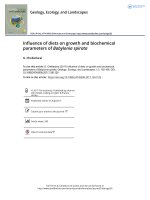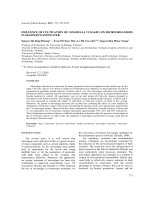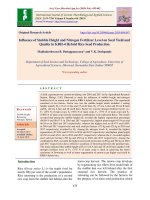Influence of weather parameters on YVMV incidence of okra varieties in summer season
Bạn đang xem bản rút gọn của tài liệu. Xem và tải ngay bản đầy đủ của tài liệu tại đây (221.5 KB, 6 trang )
Int.J.Curr.Microbiol.App.Sci (2018) 7(3): 1305-1310
International Journal of Current Microbiology and Applied Sciences
ISSN: 2319-7706 Volume 7 Number 03 (2018)
Journal homepage:
Original Research Article
/>
Influence of Weather Parameters on YVMV Incidence of
Okra Varieties in Summer Season
Vadla Usha Sree*, B.V. Asewar, A.T. Daunde, A.M. Khobragade and D.S. Perke
Department of Agricultural Meteorology, Vasanth Rao Naik Maratwada Krishi Vidhyapeeth,
Parbhani – 431 402, Maharashtra, India
*Corresponding author
ABSTRACT
Keywords
YVMV incidence,
Meteorological
parameters, Okra
varieties, Yield,
Summer season
Article Info
Accepted:
12 February 2018
Available Online:
10 March 2018
A field experiment was conducted at Experimental farm, Department of Vegetable
Research Centre, College of Agriculture, Vasantrao Naik Marathwada Krishi Vidyapeeth,
Parbhani during summer season, 2015 to find out the effect of weather parameters on
YVMV incidence of okra varieties in summer season. The experiment was conducted in
randomized block design with four replications and six varieties (V 1- Parbhani Kranti, V2Parbhani OK-1, V3-Arka Anamika, V4-Arka Abhay, V5-VRO-6 (Kashi Pragati) and V6Pusa Sawani). The results from the experiment revealed that incidence of YVMV was
initiated in March and reached maximum in May. The correlation studies revealed that
maximum and minimum temperature showed highly significant correlation (p < 0.01) with
YVMV incidence on different okra varieties. Relative humidity (maximum) was
significantly negative correlated with disease incidence. Evaporation has shown significant
correlation with disease incidence only on V2 (Parbhani OK-1). Wind velocity showed
significant positive correlation (p < 0.05) with varieties (V1, V3, V4, V5) while varieties V2
and V6 were positively correlated. Hence, the variety Parbhani Kranti can be grown in
summer season as it showed less YVMV incidence and recorded higher productivity over
other varieties.
Introduction
Okra [Abelmoschus esculentus (L.) Moench]
commonly known as lady’s finger or bhendi is
most delicious vegetable relished world over,
belongs to the family Malvaceae.
Okra fruits are rich in proteins (20-24%) and
their seeds contain 13-22% edible oil (Sheikh
et al., 2013). In general, okra is of African
origin but the cultivated species i.e.
Abelmoschus esculentus is probably of Indian
origin (Dhankar et al., 2005). It is very
important vegetable cultivated all over India
particularly in the states of Andhra Pradesh,
West Bengal, Jharkhand, Orissa, Uttar
Pradesh, Madhya Pradesh, Karnataka, Gujarat
and Maharashtra and constitutes 70% of the
total fresh vegetable earnings, excluding onion
(APEDA, 2000). In Maharashtra, bhendi is
grown throughout the year providing
continuous and good source of income to the
farmers. In Maharashtra, it was cultivated in
an area of 11.3 thousand hectares with annual
production of 84.6 thousand tones and
productivity of 7.5 t ha-1 (Anonymous, 2015).
1305
Int.J.Curr.Microbiol.App.Sci (2018) 7(3): 1305-1310
The productivity of okra has been low in
recent times due to various reasons viz.
inadequate use of fertilizers, irrigation and
occurrence of various diseases and pests.
Diseases are one of the major constraints for
low productivity of bhendi (Das et al., 2011)
and numerous fungal, bacterial, viral diseases
have been reported in India. Amongst the viral
diseases, Yellow vein mosaic virus is one of
the important and of common occurrence
wherever this crop is grown.
It was first reported in okra plants in 1924
in India (Kulkarni, 1924). The disease is
characterized by alternate green and yellow
patches, different degrees of chlorosis of
leaves and in severe cases, the chlorosis may
extend to the interveinal area and may result in
complete yellowing of leaves. Fruits are
dwarfed, malformed and turn yellow green.
Fruit yield is greatly reduced (upto 96%) if the
crop is infected at an early stage (Pun and
Doraiswamy, 1999).
The whitefly Bemisia tabaci (Genn.) species
group is the insect vector. The whitefly vector
reproduces to significant numbers during the
summer season when it transmits the virus
between okra plants. The causal agent is the
single-stranded DNA Bhendi yellow vein
mosaic virus (BYVMV), which is associated
with a small satellite DNA β component (Jose
and Usha, 2003), both of which are required
for infection. BYVMV belongs to the
genus Begomovirus,
family Geminiviridae
(Fauquet and Stanley, 2005). Several YVMV
resistant bhendi varieties have been released,
but none have retained resistance for long
(Usha, 2008). In recent times, many new
varieties resistant to YVMV has been released
but their resistance level is still of concern and
is location specific. Hence, an experiment was
planned with different resistant varieties with
objective to work out the correlation between
YVMV incidence on okra varieties and
weather parameters in summer season.
Materials and Methods
An experiment was conducted at Experimental
farm, Department of Vegetable Research
Centre, College of Agriculture, Vasantrao
Naik
Marathawada
Krishi
Vidypeeth,
Parbhani geographically situated at 190 16’
latitude and 760 47’ longitude, and at 409
meters above mean sea level. The experiment
was carried out in randomized block design
with four replications during summer season,
2015. Treatments consisted of six varieties i.e.
V1 (Parbhani Kranti), V2 (Parbhani OK-1), V3
(Arka Anamika), V4 (Arka Abhay), V5 (VRO6 [Kashi Pragati]) and V6 (Pusa Sawani).
The experimental field was typical black
cotton soil having medium fertility and good
drainage. The total rainfall received during the
crop growth period was 157.5 mm in 11 rainy
days. During this period, maximum rainfall
(91.8 mm) was received in the month of April
and minimum rainfall (24.8 mm) was received
in the month of May. The average maximum
temperature was 37.20C and minimum
temperature was 19.70C. Mean morning and
evening relative humidity was 69.7 per cent
and 23.7 per cent, respectively. The mean
bright sunshine hours was 8.98 hrs day-1,
evaporation was 9.12 mm week-1 and wind
velocity was 5.08 km hr-1 during the crop
growth period. All the varieties were sown on
17th February, 2015 with spacing 60 × 30 cm
in plots of 4.2 × 3.9 m2. The sowing of seed
was done by dibbling method. Recommended
dose of fertilizers @ 80-40-40 NPK kg ha-1
was applied. Half dose of nitrogen and
complete dose of phosphorus and potassium
was applied at the time of sowing and
remaining half dose of nitrogen was applied at
30 DAS. The fruits were picked from plots of
3.0 × 2.7 m2 and first picking was done at 60
DAS and subsequent pickings were done at
every third day, a total of 10 pickings were
obtained. The test crop was harvested on 27th
May, 2015. The plot wise yield was converted
1306
Int.J.Curr.Microbiol.App.Sci (2018) 7(3): 1305-1310
per hectare and represented as q ha-1.
Recommended agronomic practices were
followed to raise the crop.
Observations recorded
Pathological
observations
i.e.
disease
incidence of YVMV of different okra varieties
were recorded from 30 DAS to harvest at
every week interval with five randomly
selected plants. Meteorological observations
include rainfall (mm), maximum and
minimum temperature (0C), maximum and
minimum humidity (%), bright sunshine hours
(hrs day-1), wind speed (km hr-1) and
evaporation (mm day-1) were recorded weekly.
Data analysis
The data pertaining to incidence of yellow
vein mosaic virus was correlated with various
weather factors. The correlations between
weather parameters and disease incidence
were studied. The relationship between fruit
yield and per cent YVMV incidence was
represented graphically.
Results and Discussion
Pathological observations
The YVMV disease evaluation was carried out
at weekly intervals from 30 DAS to harvest.
The per cent incidence of YVMV of different
varieties was presented in Table 1. The
YVMV incidence was initiated in March (30
DAS) and with the age of the crop the YVMV
incidence increased progressively and reached
maximum in the month of May (harvest stage)
for all the varieties.
The YVMV incidence was increased for all
the varieties from 75 DAS and that has
resulted in low yields. During crop growth
period, the mean per cent incidence of YVMV
was found highest (28.1) in variety V6 (Pusa
Sawani). This variety is susceptible to YVMV
and hence, recorded lowest yield. Similar
findings of yellow vein mosaic disease on
okra varieties were reported by Ajay et al.,
(2012). The lowest (7.8) per cent incidence of
YVMV was observed in V1 (Parbhani Kranti).
This variety is resistant to the viral disease and
was found in accordance with findings of
Bhagat et al., (2001).
Relationship between okra fruit yield and
YVMV incidence
Significant negative correlation between fruit
yield and per cent incidence of YVMV was
observed (R2= 0.755, p < 0.05) (Figure 1). As
the YVMV incidence is increased the fruit
yield decreased. The similar findings of
yellow vein mosaic disease on okra varieties
were reported by Ajay et al., (2012).
Correlation between weather parameters
and YVMV incidence
The correlation between the weather
parameters and disease incidence of different
okra varieties was presented in Table 2. All
the varieties have shown negative correlation
with rainfall for YVMV disease incidence.
Maximum temperature showed highly
significant correlation (p < 0.0.1) with disease
incidence of different okra varieties. Minimum
temperature showed significant correlation (p
< 0.05) with disease incidence in all the
varieties. As the temperature raised from April
the disease incidence has also increased in all
the varieties. Similar findings of temperature
on disease incidence were observed by
Muhammad et al., (2012). Relative humidity
was negatively correlated with disease
incidence and the level of significance (p <
0.05) was observed for all the varieties except
V2. Evaporation observed significant positive
correlation (p < 0.05) with disease incidence
only for V2 while for the rest of varieties the
level of significance was not obtained.
1307
Int.J.Curr.Microbiol.App.Sci (2018) 7(3): 1305-1310
Table.1 Incidence of YVMV on different varieties of okra
MW
(no.)
Month
period
V1
V2
V3 (Arka
V4
V5
(Parbhani (Parbhani Anamika) (Arka (VROKranti)
OK-1)
Abhay)
6)
Per cent (%) incidence of YVMV
0.12
0.23
0.44
0.23
0.11
12
19-25 March
13
26-01 April
0.10
2.01
3.10
0.55
0.23
0.22
14
02-08 April
1.32
3.10
5.70
0.44
0.48
0.42
15
09-15 April
2.75
7.11
6.25
2.13
5.43
0.73
16
16-22 April
4.22
10.01
10.5
4.25
6.13
0.95
17
23-29 April
7.35
13.12
12.6
5.34
8.23
15.34
18
30-06 May
9.20
15.24
15.35
7.43
9.45
39.39
19
07-13 May
11.25
16.94
19.49
9.41
10.45
64.96
20
14-20 May
21.23
28.76
31.31
23.07
22.27
76.78
21
21-27 May
26.55
34.08
36.63
28.39
27.59
82.1
7.8
15.35
14.13
8.1
9.0
28.1
Mean
V6
(Pusa
Sawani)
0.11
Table.2 Correlation between different weather parameters and YVMV disease incidence of
different okra varieties
Weather
Varieties
V1
(Parbhani
kranti)
-0.178
V2
(Parbhani
OK-1)
-0.065
V3
(Arka
anamika)
-0.170
V4
(Arka
abhay)
-0.217
V5
(VRO6)
-0.149
V6
(Pusa
sawani)
-0.319
Temp max.
0.933**
0.966**
0.965**
0.955**
0.949**
0.950**
Temp min.
0.673*
0.736*
0.708*
0.681*
0.658*
0.711*
RHmax
-0.702*
-0.626
-0.694*
-0.718*
-0.649*
-0.793**
RHmin
-0.223
-0.298
-0.246
-0.235
-0.166
-0.324
Evaporation
0.617
0.632*
0.598
0.623
0.598
0.587
Bright
sunshine
hours
Wind speed
0.172
0.125
0.165
0.175
0.182
0.048
0.749*
0.600
0.670*
0.741*
0.726*
0.614
Rainfall
*
**
significant at 5 %, significant at 1%
1308
Int.J.Curr.Microbiol.App.Sci (2018) 7(3): 1305-1310
Fig.1 Relationship between okra fruit yield and per cent incidence of YVMV
Wind velocity observed significant positive
correlation (p < 0.05) with varieties (V1, V3,
V4 and V5) while only positive correlation
was observed for V2 and V6. Similar findings
of weather parameters were reported by Das
et al., (2011).
The present study suggests that the incidence
of YVMV increased towards the harvest
period (May). The positive correlation
between weather parameters and YVMV
disease incidence showed that disease
incidence increased with increase in
maximum and minimum temperature and
maximum relative humidity. Hence, the
variety Parbhani Kranti can be grown in
summer season as it showed less YVMV
incidence and recorded higher yield compared
to other varieties.
References
Ajay, T., Singh, B., Singh, T.B., Sanval, S.K.,
and Pandey, S.D. 2012. Screening of
okra varieties for resistance to yellow
vein mosaic virus under field condition.
Hort Flora Research Spectrum. 1(1):
92-93.
Anonymous. 2015. Horticultural Statistics at a
Glance. Horticulture Statistics Division,
Department of Agriculture, Cooperation
and Farmers Welfare, Government of
India, New Delhi.
APEDA. 2000. Agro-export statistics.
Agriculture and Processed Food Export
Development Agency, New Delhi,
India.
Bhagat, A.P., Yadav, B.P., and Prasad, Y.
2001. Rate of dissemination of okra
yellow vein mosaic virus disease in
three cultivars of Okra. Indian
Phytopathology. 54(4): 488-489.
Das, S., Pandey, V., Patel, H.R., and Patel,
K.I. 2011. Effect of weather parameters
on pest-disease of okra during summer
season in middle Gujarat. Journal of
Agrometeorology. 13(1): 38-42.
Dhankar, B.S., Mishra, J.P., and Bisht, I.S.
2005. Okra. In: Dhillon, B.S., Tyagi,
R.K., Saxena, S., and Randhawa, G.J.
1309
Int.J.Curr.Microbiol.App.Sci (2018) 7(3): 1305-1310
(eds). Plant Genetic Resources:
Horticultural Crops, pp 59-74. Narosa
Publishing House, New Delhi, India.
Fauquet, C.M., and Stanley, J. 2005. Revising
the way we conceive and name viruses
below the species level: a review of
Gemini virus taxonomy calls for new
standardized
isolate
descriptors.
Archives of Virology. 150: 2151-2179.
Jose, J., and Usha, R. 2003. Bhendi yellow
vein mosaic disease in India is caused
by association of a DNA β satellite with
a begomovirus. Virology. 305: 23102317.
Kulkarni, C.S. 1924. Mosaic and other related
diseases of crops in the Bombay
Presidency. Poona Agriculture College
Magazine. 16.
Muhammad, E., Ali, M.I., Khan, M.A.
Rashid, M., Javed, M.T., and Sajid, M.
2012. Epidemiology of Okra Yellow
Vein Mosaic Virus (OYVMV) and its
Management through Tracer, Mycotal
and Imidacloprid. American Journal of
Plant Sciences. 3: 1741-1745.
Pun, K.B., and Doraiswamy, S. 1999. Effect
of age of okra plants on susceptibility to
Okra yellow vein mosaic virus. Indian
Journal of Virology. 15: 57-58.
Sheikh, M.A., Safiuddin., Khan, Z., and
Mahmood, I. 2013. Effect of bhendi
yellow vein mosaic virus on yield
components of okra plants. Journal of
Plant Pathology. 95(2): 391-393.
Usha, R. 2008. Bhendi yellow vein mosaic
virus. In: Rao, G.P., Kumar, P.L., and
Holgun-Pena,
R.J.
(eds).
Characterization,
Diagnosis
and
Management of Plant Viruses. Vol. 3,
pp. 387-392. Studium Press, Houston,
Texas, USA.
How to cite this article:
Vadla Usha Sree, B.V. Asewar, A.T. Daunde, A.M. Khobragade and Perke, D.S. 2018.
Influence of Weather Parameters on YVMV Incidence of Okra Varieties in Summer Season.
Int.J.Curr.Microbiol.App.Sci. 7(03): 1305-1310. doi: />
1310


